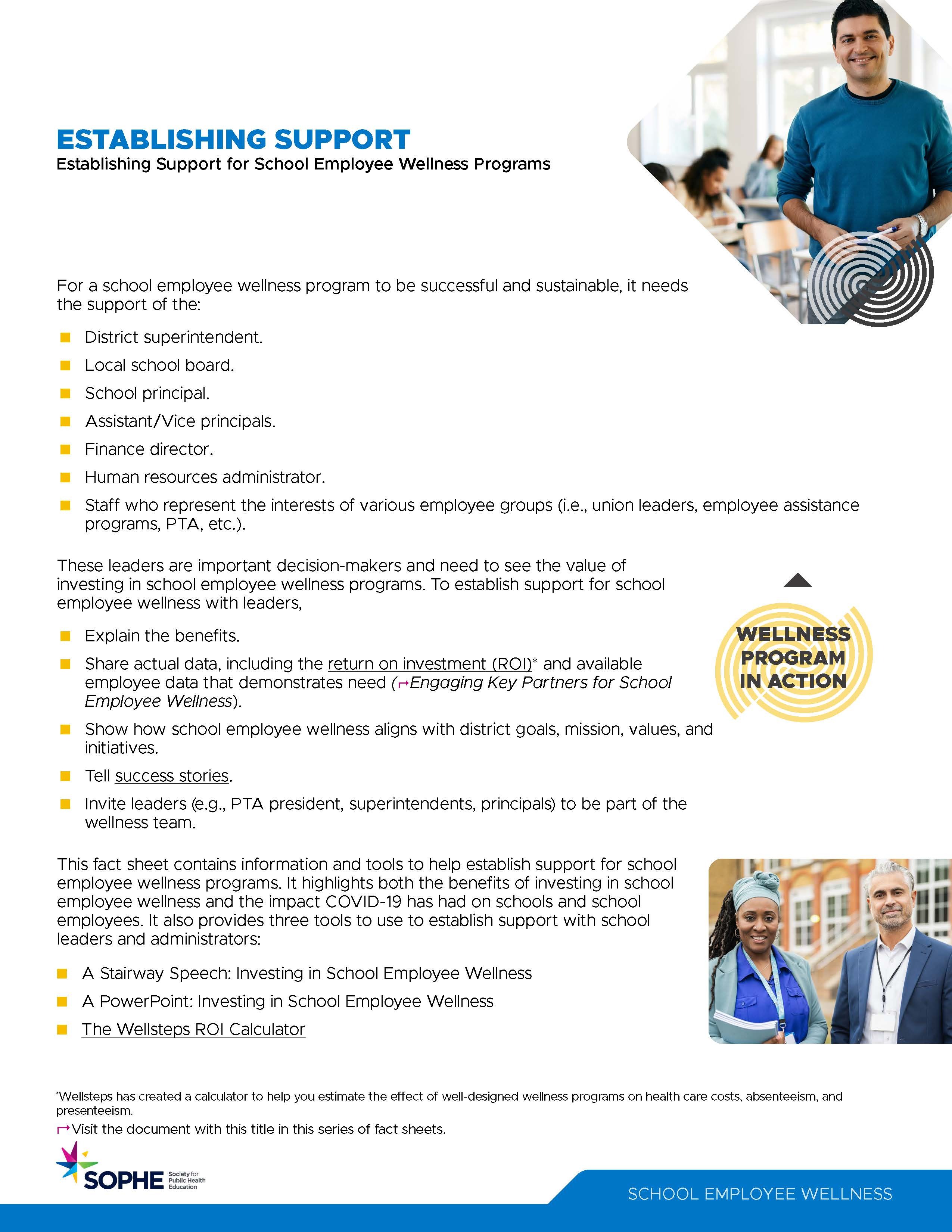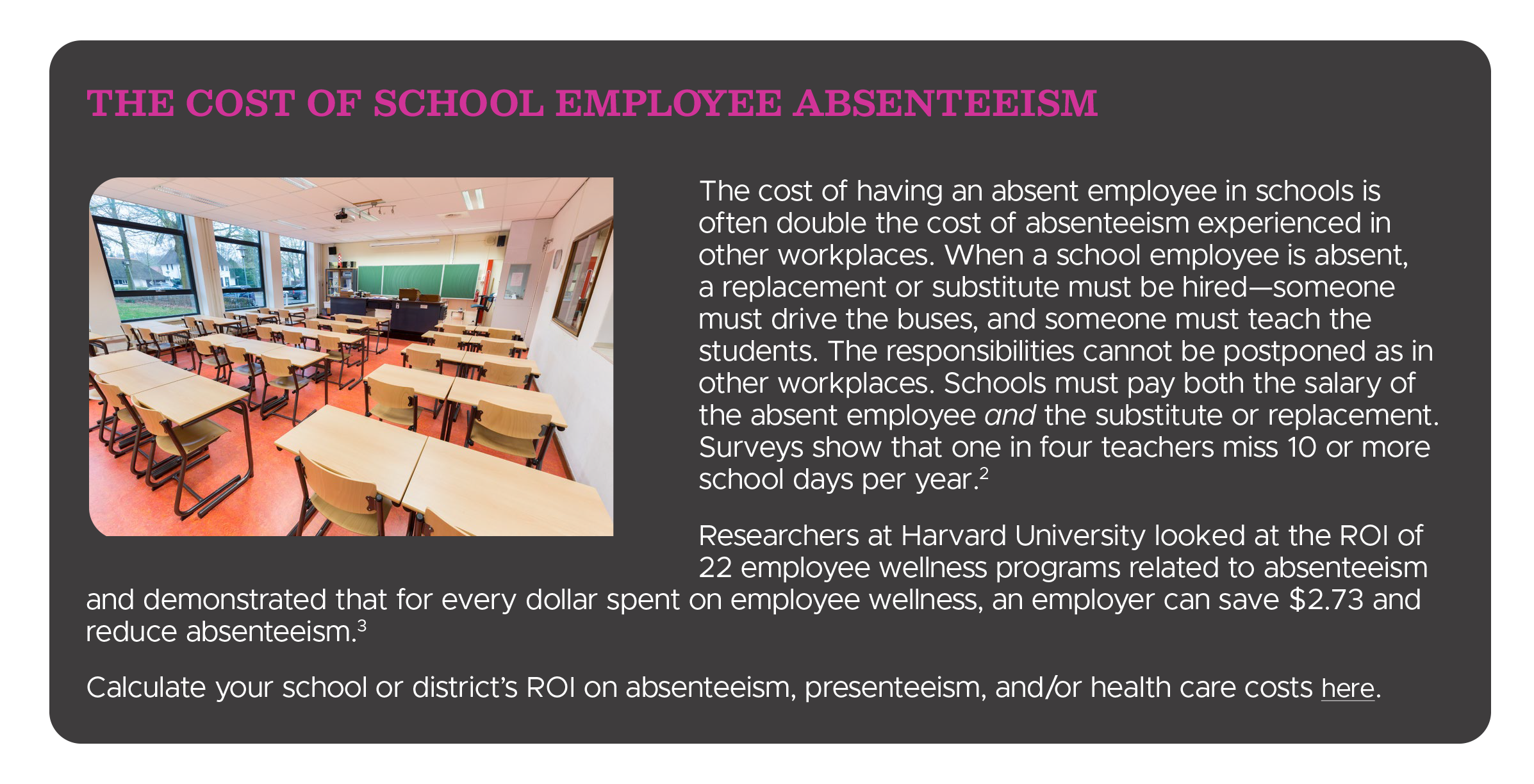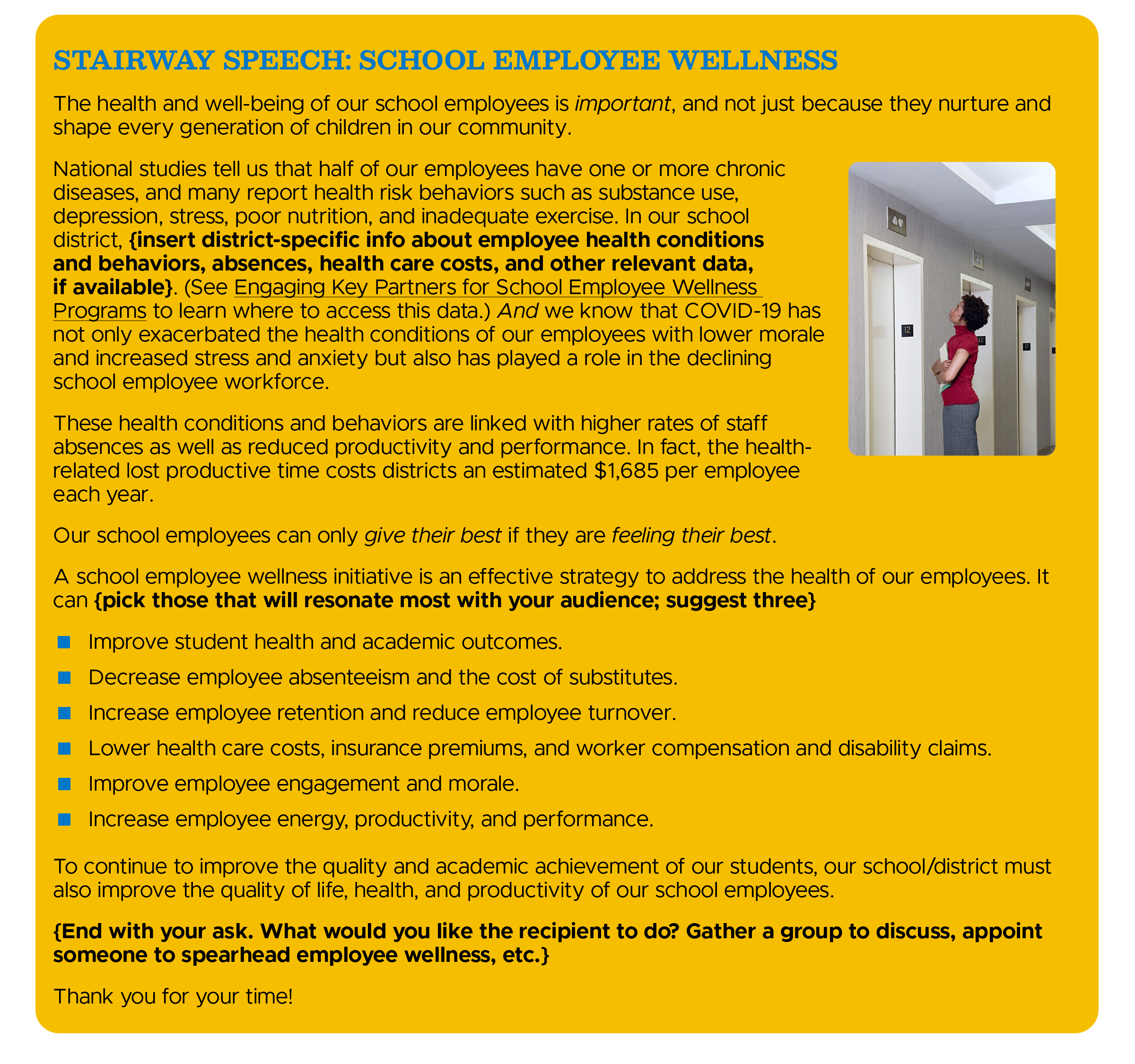
Establishing Support for School Employee Wellness Programs

This fact sheet provides information and tools to help establish support for school employee wellness. It highlights the potential benefits of investing in school employee wellness, as well as the impact COVID-19 has had on schools and school employees, and provides three tools to use when establishing support with school leaders and administrators:
- A Stairway Speech: Investing in School Employee Wellness
- A PowerPoint: Investing in School Employee Wellness
- Wellsteps Return on Investment (ROI) Calculator
To download fact sheet, please click Establishing Support for School Employee Wellness.
The Benefits of School Employee Wellness
School districts must pay for employee absenteeism, health care costs, workers’ compensation, lost productivity, and disability. School districts are also struggling to attract and retain employees. Employee wellness programs can directly affect each of these employee-related costs.
Benefits of investing in school employee wellness include:
- Improved student health and academic outcomes.
- Decreased employee absenteeism, presenteeism, and the cost of substitutes.
- Increased employee retention/reduced employee turnover.
- Enhanced recruitment of prospective employees.
- Lower health care costs, insurance premiums, and worker compensation and disability claims. Improved employee health, including reduced stress and substance use.
- Improved employee engagement, morale, and resilience.
- Increased employee energy, productivity, and performance.
Employee wellness efforts have clear benefits for school employees, students, the school climate, the school budget, and the health care system.

A Stairway Speech: Investing in School Employee Wellness
A stairway speech or pitch is a summary statement used to quickly and simply explain an important idea in the time span of an elevator ride, a few flights of stairs, or about 30 to 90 seconds. This statement typically explains the idea, shows why it is important (including its benefits), and closes with an ask.
Below is a sample stairway speech that can be used with your school’s or district’s leadership, board members, community partners, etc. (See Engaging Key Partners for School Employee Wellness). Though most often a stairway speech is delivered verbally, it can be used in a presentation (See A PowerPoint:Investing in School Employee Wellness) or an e-mail.

A PowerPoint Presentation: Investing in School Employee Wellness
This presentation can be used with school leaders and administrators to help establish support for school employee wellness. This presentation provides
- A brief introduction to the Whole School, Whole Community, Whole Child (WSCC) model.
- An overview of the benefits of school employee wellness.
- The ROI of an employee wellness program on employee absenteeism.
- An opportunity for each school/district to share their own ROI or cost savings related to obesity, smoking, and wellness programs using the Wellsteps ROI Calculator.
- An opportunity for each school/district to share data about the health of their school employees, including employee-absence data, health care costs, workers’ compensation, and employee health conditions/behaviors. (See Engaging Key Partners for School Employee Wellness to learn where to access this data.)
- Data about the impact of the COVID-19 pandemic on the school workforce.
- An opportunity to engage in a conversation about employee wellness at your school/district.
Talking points are included with the PowerPoint, accessed here.
References
1Employees’ National Association of Chronic Disease Directors, Healthy School, Healthy Staff, Healthy Students: A Guide to Improving School Employee Wellness (Decatur, GA: National Association of Chronic Disese Directors, 2018), https://chronicdisease.org/healthy-school-staff-students-a-guide-to-improving-school-employee-wellness/
2Sarah D. Sparks, “1 in 4 Teachers Miss 10 or More School Days, Analysis Finds,” Education Week, June 27, 2016, https://www.edweek.org/leaders...
3Katherine Baicker, David Cutler, and Zirui Song, “Workplace Wellness Programs Can Generate Savings,” Health Affairs 29, no. 2 (February 2010):304–11, https://doi.org/10.1377/hlthaff.2009.0626.
4Unpublished thesis survey with anonymous responses, Wayne State University, August 2022.
5National Center for Education Statistics, “U.S. Schools Report Increased Teacher Vacancies Due to COVID-19 Pandemic, New NCES Data Show,” March 3, 2022, https://nces.ed.gov/whatsnew/press_releases/3_3_2022.asp
6National Center for Education Statistics, “U.S. Schools Report Increased Teacher Vacancies.”
7National Center for Education Statistics, “U.S. Schools Report Increased Teacher Vacancies.”
8“Job Openings and Labor Turnover Survey,” U.S. Bureau of Labor Statistics, September 8, 2022,https://www.bls.gov/jlt/
9Joseph Hedger and the National Association of State Boards of Education, “Five Questions to Ask about School Staff Wellness in the Wake of COVID-19,” Power of the Question 5, no. 2 (June 2021), https://www.nasbe.org/five-questions-to-ask-about-school-staff-wellness-in-the-wake-of-covid-19/
10GBAO and the National Education Association, Poll Results: Stress and Burnout Pose Threat of Education Shortage (Washington, DC: National Education Association, January 31, 2022),https://www.nea.org/sites/default/files/2022-02/NEA%20Member%20COVID-19%20Survey%20Summary.pdf
11GBAO and the National Education Association, Poll Results: Stress and Burnout Pose Threat of Education Shortage .
12Doris A. Santoro and Olga Acosta Price, Structural Supports to Promote Teacher Well-Being (Providence, RI: EdResearch for Recovery, October 2021), https://annenberg.brown.edu/sites/default/files/EdResearch_for_Recovery_Brief_19.pdf
13Mark T. Greenberg, Joshua L. Brown, and Rachel Abenavoli, Teacher Stress and Health: Effects on Teachers, Students, and Schools, Edna Bennett Pierce Prevention Research Center, Pennsylvania State University, September 2016, https://prevention.psu.edu/publication/teacher-stress-and-health-effects-on-teachers-students-and-schools/
14Daniel J. Madigan and Lisa E. Kim, “Does Teacher Burnout Affect Students? A Systematic Review of Its Association with Academic Achievement and Student-Reported Outcomes,” International Journal of Educational Research 105, (2021): 101714, https://doi.org/10.1016/j.ijer.2020.101714.
| Access Date | Quiz Result | Score | Actions |
|---|

